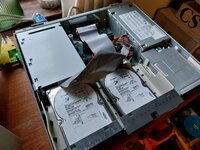ArmorAlley
Well-known member
So, the message we're giving the OP is to type two spaces after the end-of-sentence-point and then use the auto-correct to remove them?
This isn't actually true. Professor James V. Wertsch was the one who started the false accusation, and he did it with completely wrong information. He created a chart claiming it showed that the most common letter combinations required the typist to strike using the same finger, slowing it down. The problem is that he based this theory on a then-modern typewriter, and not the actual typewriters of the 1870s and 1880s, on which they were struck with different fingers. Not to mention that E, T, O, and I are all on the same row.What's equally fascinating is we still use the QWERTY keyboard layout which was deliberately engineered to limit the top end of human typing speed.
So, you're saying the design could always optimise the bartypes so that the keyboard layout was pretty optimal, but it still didn't tend to jam? I say 'tend', because it's always possible to smack down a bunch of keys at the same time to make it jam.Not to mention that the orientation of the bartypes for the basket and the keys can be arranged independent of each other when manufacturing the typewriter. So if it were true from the mechanical standpoint, then there'd be zero reason to arrange the keyboard in a less optimal layout when the basket be could modified so the bartypes in more common combinations are further spaced.


Dang, that's tough...My 6100's hard disk is playing up
The driver or partition map got corrupted, I spent a couple of hours bring it back up (it's tricky because Drive Setup refused to deal with it in its broken condition)... Got it booting again... But it is starting to glitch in odd ways again already.
Real shame. It's a nice fast 9GB Seagate disk from the early 2000s. They're hard to get at a good price these days.
View attachment 66914
Sadly it is just how things are these days.Dang, that's tough...
ZuluSCSI time?Sadly it is just how things are these days.
One fewer disk at the moment. I'm sharing one disk between three computers already, but I might be able to redistribute disks, I think a couple of machines have two disks in them.ZuluSCSI time?
:-(One fewer disk at the moment. I'm sharing one disk between three computers already, but I might be able to redistribute disks, I think a couple of machines have two disks in them.
I have some disks I got lately but I want to bench test them first because several of them instantly let the magic smoke out and one shorted and killed my ATX PSU I was testing them with... Wasn't massively pleased.
Well, safe to say, they are history! Impressed that you're still trying to source real SCSI drives. I have 3 SCSI drives: my original Performa 400 drive which is in a SCSI box connected to my Plus; a 100MB SCSI drive whose history I'm unsure of (maybe comes from my SE), but which still works decades later: it's called "Centurion"; a 260MB HD which I originally intended to replace my P400 one, but was never reliable and it's in another SCSI box.Not sure what their history is.
Have a working 20MB MiniScribe in an SE and a 5" 20MB disk in a 20SC enclosure here, but most of my disks are 9 or 18GB Seagates. Bought a load from someone decommissioning some servers from the early 2000s... They've done a lot of hours but most of them have been good. I think one never worked, one was always temperamental and this is the first to start to fail out of about 15?:-(
Well, safe to say, they are history! Impressed that you're still trying to source real SCSI drives. I have 3 SCSI drives: my original Performa 400 drive which is in a SCSI box connected to my Plus; a 100MB SCSI drive whose history I'm unsure of (maybe comes from my SE), but which still works decades later: it's called "Centurion"; a 260MB HD which I originally intended to replace my P400 one, but was never reliable and it's in another SCSI box.
I plan to get a PICO-based ZuluSCSI for the SE when it's finally fixed, thanks to @croissantking 's donated flyback.
Yeah, you're right. It doesn't make much sense as to why the SD-SCSI devices are so expensive. I probably could bodge a cable that can use an SD card slot to a SCSI cable.Have a working 20MB MiniScribe in an SE and a 5" 20MB disk in a 20SC enclosure here, but most of my disks are 9 or 18GB Seagates. Bought a load from someone decommissioning some servers from the early 2000s... They've done a lot of hours but most of them have been good. I think one never worked, one was always temperamental and this is the first to start to fail out of about 15?
I just find the SD card solutions a bit expensive. If you keep watching you occasionally find a 50 pin disk for much less money. I don't mind too much if one fails every now and then, it isn't like I'm storing work on them. I just back up projects regularly to modern computers.
Wow, if you could, please share your designI probably could bodge a cable that can use an SD card slot to a SCSI cable.
